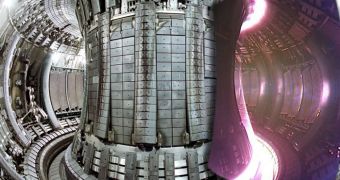Bringing the Sun to Earth, that's what nuclear physicists dream of today. The imminent depletion of fossil fuels, the inefficiency of renewable power sources and dangers posed by the use of nuclear fissionable fuels point to only one future energy-production solution, nuclear fusion. More than two thirds of the Earth surface is covered with the substance containing the fuel required to power such nuclear reactor, and if developed, these devices could provide with more energy than we could ever dream of; not to mention that nuclear fusion is roughly the most clear energy-production process ever created.
For now however, the project is dead in the water. The magnetic fields required to confine the nuclear fusion reaction draws so much power from the energy supply, that the reactor shuts down only after about a couple of seconds after being started, due to the inability to sustain itself. Now, scientists have figured the correct model which should provide with the needed electromagnetic configurations to confine the fusion implosions so that it would have a substantial effect on the dynamics of the implosion and diagnosis.
The research has been made by Ryan Rygg, from the Lawrence Livermore National Laboratory, in collaboration with researchers from the Massachusetts Institute of Technology and University of Rochester. With the help of a radiography technique used on a pulsed monoenergetic proton source, that is in direct relation with the field strength and plasma density, physicists have determined how much energy the protons are losing during the implosion phase of the reaction.
Nuclear fusion reactions determined by the inertial confinement fusion, or ICF for short, are initiated through a process which implies heating and compressing the fuel into a spherical shape, containing mixtures of deuterium and tritium gas, two of the isotopes of hydrogen. The heating is realized with the help of lasers, which break down the gas into a plasma, after which it can be easily manipulated with powerful magnetic field to concentrate it into a small as possible volume.
For example, the facility used for the study, namely the OMEGA laser in Rochester, implies the use of 36 different laser systems to heat the fuel, capable of delivering about 14 kilojoules of energy into a time interval as small as a nanosecond. During the heating stage - basically an implosion - Rygg has observed that X-ray radiography of the reaction process reveals a filamentary magnetic field, as well as a coherent electric field in the vicinity of the imploding capsules, while being compressed to half of the original radius.
Rygg writes that, by measuring the electric field, physicists could eventually create a map of the pressure dynamics during the implosion, to evaluate the efficiency of the process, as well as an image of the structure which produces that critical surface at different time intervals, practically opening the way towards the development of the first nuclear fusion reactor.

 14 DAY TRIAL //
14 DAY TRIAL //